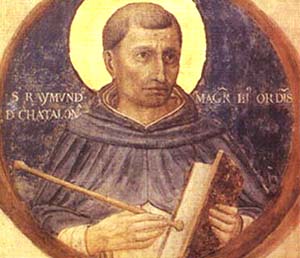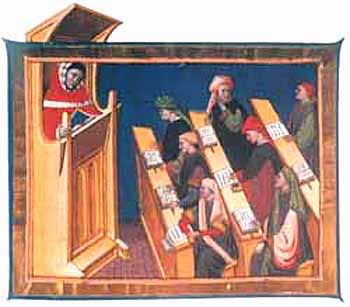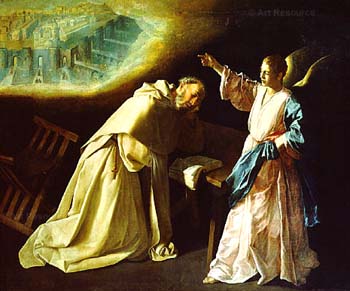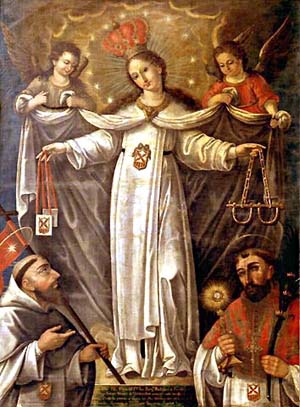 |
The Saint of the Day
St. Raymond of Peñafort – January 23
Prof. Plinio Corrêa de Oliveira
Biographical selection:
Raymond (1175-1275) was born into a wealthy and noble family related to the royal family of Aragon. He was born at the Castle of Peñafort in Villafranca, near Barcelona, Spain, in 1175.
At age 20 he was already teaching philosophy at Barcelona. After 15 years, he resigned from that chair and went to Bologna to study civil and canon law. He received his doctorate in 1216 and occupied a first chair of canon law in the university for three years.

St. Raymond of Peñafort
|
The city Senate, hoping to retain him in the city, presented him with special rewards for his work. However, he did not remain, because Pope Honorius III asked him to return to Spain to tutor King James I of Aragon.
He had been attracted to the Dominican Order by the preaching of Blessed Reginald, prior of Bologna, and also met St. Dominic of Gusman there. In Barcelona he received the Dominican habit in 1222. His example attracted many great personages to the Order.
During his novitiate, he asked a penance for his past vanities while teaching, and he was ordered to write a book on cases of conscience for the guidance of confessors and moralists. This work, entitled The Summa of Penitential Cases, or Summa Casuum, was the first guide of this kind to be compiled. His work was praised by Pope Clement VIII.
In 1229 Pope Gregory IX sent the Cardinal of Sabina, John of Abbeville, to Spain to convoke the princes of the region and stimulate them to continue the valiant fight against the Moors. The Cardinal invited St. Raymond, who had been his theologian and penitentiary, to be his first assistant. St. Raymond would enter a city, preach the crusade to the people, and hear confessions in order to prepare the public for the arrival of the Cardinal. Then the Cardinal of Sabina would come to bless the crusade and grant the Papal indulgences for it.

A master teaching at the University of Bologna, which became famous for its studies in civil and canon law
|
When the Cardinal of Sabina returned to Rome, he reported to the Pope the great merits of St. Raymond. Pope Gregory IX was impressed and summoned him to Rome to be his chaplain and confessor. One of the penances Raymond would give the Pope was to not delay in seeing to the needs of the poor.
Pope Gregory IX gave St. Raymond the job of ordering and codifying the canon laws of the Church. It was an immense work, since he had to rewrite and condense decrees that had been accumulating for centuries. Completed in 1234, the work remained the most authoritative compilation within the body of canon law until 1917, when a new code was published. Due to the excess of work, St. Raymond fell ill. Fearful that he would die if he remained in Rome, his physicians recommended that he return to his monastery in Barcelona.
At the request of various Bishops, he set out the ceremonial to be followed by Bishops when they visited diocesan churches. He also composed a treatise on fair price in commerce to keep merchants from stealing from the public.
One of the most brilliant rays of St. Raymond’s glory was to assist in founding the Order of Our Lady of the Mercy, or Mercedarians, for the redemption of the captives. The order was established because of a heavenly revelation made simultaneously to King James I of Aragon, St. Raymond, and St. Peter Nolasco.

The dream of St. Peter Nolasco by Zurbaran
|
To inaugurate the new Order, the King with his court and the Magistrates of the city of Barcelona assisted at solemn ceremony in the Cathedral of the Holy Cross. Bishop Berengarius said the Holy Mass, and St. Raymond delivered the sermon in which he described the triple heavenly revelation ordering the founding of the new order. At the Offertory the King and St. Raymond presented St. Peter Nolasco to the Bishop as its first superior and he received the new habit from the Bishop. In his turn, St. Peter received thirteen nobles as the first members of the newly-born Order. When the Mass ended, the Monarch processed out with St. Peter and his monks to his palace, where he had reserved a wing of it to be their first Monastery. St. Raymond never ceased his work in spreading the Order of the Mercedarians until the end of his life.
By another revelation from God, St. Raymond was given to know that God wanted the conversion of the Moors and Jews who were numerous in Spain. From then on, he made special efforts to achieve this aim. He founded institutes at Barcelona and Tunis for the study of Eastern languages in order to convert the Moors and Jews. By 1256, he was able to write to his Superior telling him that 2,000 Mohammedans had received Baptism.
Many Muslim clerics, however, were very proud and did not want to change their thinking. So St. Raymond asked St. Thomas Aquinas to write a work to convince them of their errors and help them convert to the truth of the Catholic Church. This is how the Summa contra gentiles, The Summa against the Gentiles, one of St. Thomas’ most famous works, was born. It occasioned many conversions of the Muslim clergy.
St. Raymond reached an extreme old age. He died peacefully on January 6, the Feast of the Epiphany, in 1275, at age 100. On the feast day when God was glorified by the Kings symbolizing all the peoples, this man who had fought so much for the conversion of the gentiles died. During his last moments, the Kings of Aragon and Castile were visiting him and had the privilege to receive his last blessing.
Comments of Prof. Plinio:
The life of St. Raymond, which is characteristic of the Middle Ages, suggests some considerations regarding the good acceptation of the Saints by society and its consequences for the glory of God.
According to Catholic doctrine, it is very difficult for anyone to be in the state of grace. Because of original sin, it is impossible, naturally speaking, for anyone to be in the state of grace, that is, to share the supernatural life of God. Even after Baptism, man cannot practice durably all the Commandments of God. He may practice all of them at times, or else habitually practice only this or that Commandment, but he cannot practice all the Commandments durably. He needs supernatural grace for that.

The peace of the medieval cities is another sign of
the presence of God in the souls of those who built them
|
God gives sufficient grace to practice the Commandments to all Catholics. No one is excluded. As long as one prays for this, he will receive abundant graces that will reinforce the actual grace and help him to do what is right. With this, then, a man can be in the state of grace and durably maintain it.
Given man’s social nature, when many persons are in the state of grace it becomes easier for each individual to maintain it. Therefore, when you have a considerable number of persons in a city who live in the state of grace, you can say with a certain imprecision that this city is in the state of grace.
Properly speaking a city does not have a soul. It has something analogous to a soul which is the moral entity formed by the interaction among the individuals of the city and their mutual influence on one another. This moral entity has a certain unity that defines the city. Our Lord himself confirmed this reality when He cried over Jerusalem and lamented as if He were speaking to a person: “O Jerusalem, Jerusalem, thou that kills the prophets, and stoned them that are sent to thee, how often would I have gathered together thy children, even as a hen gathers her chickens under her wings, and thou would not?” (Mat. 23:37)
Therefore, one can say that God has determined plans for this or that city. One can also say that a city is or is not faithful to the grace, or even that a city is or is not in a state of grace.
Now then, how can one know when this or that city is in a state of grace and is corresponding to the plans God has for it?
Someone might immediately object: It is impossible to know when an ensemble of individuals is in a state of grace, because those persons can be pretending that they are in the state of grace when they really are not.
The objection presents a good point. Further, along those same lines, if someone were to ask an individual if he is in the state of grace, he would have the right to hide his interior state. He is only required to answer to his confessor, no one else. Therefore, it would seem impossible to know when an ensemble of persons is in a state of grace.
Notwithstanding, there is a test that we can apply to know when a city or an epoch is in a state of grace, and it works very well.
When persons in the state of mortal sin are together, there are three possible degrees of evil that can result. In the first degree, there are simply those who are in mortal sin, and nothing further. In the second degree, there are those who are glad to be in mortal sin; they have antipathy toward those who are in the state of grace. In the third and worse degree, there are those who promote mortal sin; they are openly hostile to those in the state of grace; they hate those who are good. Among those who represent these three degrees a curious psychological phenomenon takes place: they instinctively form a front against the good.
The consequence is that in a city where many people are in state of mortal sin, good persons are not well-received. On the contrary, in a city where many people are in the state of grace, the good are very well-received.
In epochs when saints are the object of general enthusiasm, one can say that most of the population is living in the grace of God. On the contrary, in epochs when saints are persecuted, it can be said that most of the population is not in the grace of God. The way an epoch treats a saint is the way it treats God. Most of the inhabitants of that epoch reveal their position before God in this way. The saint is an image of God; whoever loves the image, loves God, and whoever hates the image, hates God.

Our Lady of Mercy with the Order's founders,
St. Raymond at left and St. Peter Nolasco
|
When we study the lives of the saints, we can analyze how the people of their times treated them. If they were treated well, this reveals an epoch in which most of the people were in the grace of God. The opposite is also true.
When an epoch is living in the grace of God, the seeds of a Catholic Civilization are planted and, from there will take root and grow. When this Civilization is established, it will influence more people to live in the grace of God.
The life of St. Raymond of Peñafort is a remarkable example of this. His brilliant career, the influence he exerted on Popes and Cardinals, Kings and Magistrates, the cities that he conquered by his wisdom and that sought to keep him and not let him go, the unremitting success of his sermons and exhortations, and the fruitful result of his initiatives show the general approval he received from the people of his epoch. That epoch must have been an epoch in which most of the people were in the grace of God.
From these considerations about the life of St. Raymond of Peñafort, we see that to build a Catholic Civilization is not an impossible dream. To work for the Reign of Mary is not a chimera. It is a promise of Our Lady of Fatima that will be realized. She foretold: “In the end my Immaculate Heart shall triumph.” Her heart symbolizes her spirit, her mentality. What will she triumph over? First, she will triumph over the errors of Russia - Communism - that she came to denounce, and then the entire Revolution of which Communism is just one step.
This promise points to an enormous chastisement that will come to open the doors of an epoch when saints with the mentality of Our Lady will govern humankind. She will govern through her saints. They will return to influence Popes and Kings, the great and small ones on earth, and bring all to her.
Let us ask Our Lady through the intercession of St. Raymond of Peñafort to make us worthy of be living stones of this new era.


  | |
Prof. Plinio Corrêa de Oliveira | |
The Saint of the Day features highlights from the lives of saints based on comments made by the late Prof. Plinio Corrêa de Oliveira. Following the example of St. John Bosco who used to make similar talks for the boys of his College, each evening it was Prof. Plinio’s custom to make a short commentary on the lives of the next day’s saint in a meeting for youth in order to encourage them in the practice of virtue and love for the Catholic Church. TIA thought that its readers could profit from these valuable commentaries.
The texts of both the biographical data and the comments come from personal notes taken by Atila S. Guimarães from 1964 to 1995. Given the fact that the source is a personal notebook, it is possible that at times the biographic notes transcribed here will not rigorously follow the original text read by Prof. Plinio. The commentaries have also been adapted and translated for TIA’s site.
|
Saint of the Day | Home | Books | CDs | Search | Contact Us | Donate

© 2002- Tradition in Action, Inc. All Rights Reserved
|
 |
|